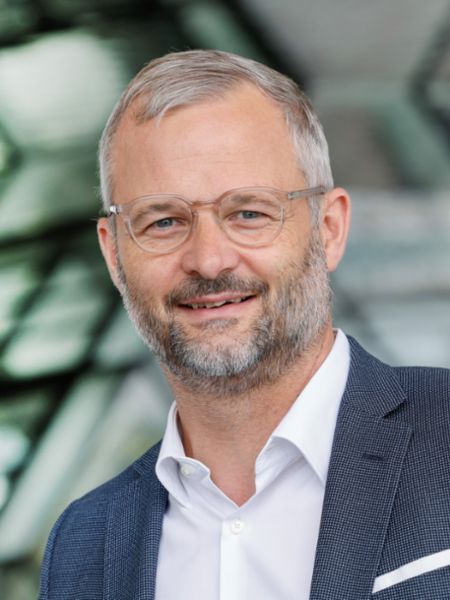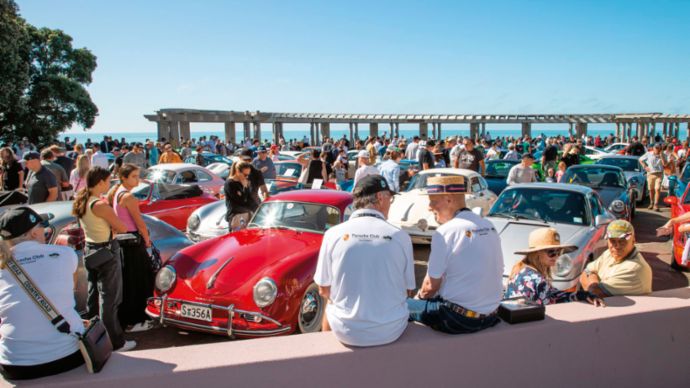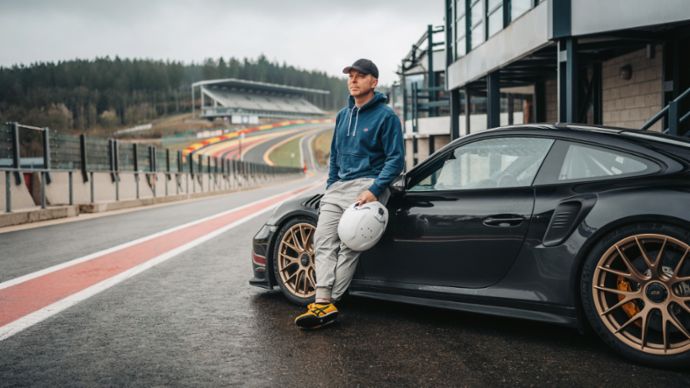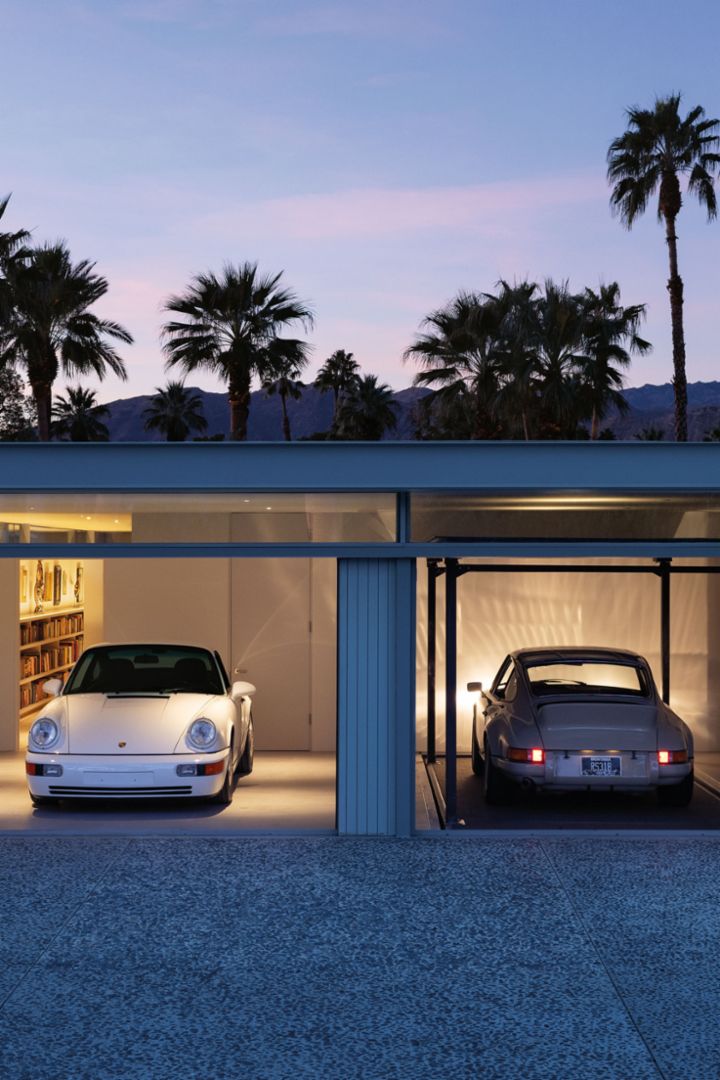Space Exploration
Roadbook: Darwin – Tennant Creek
Exploring the outback with Porsche brand ambassador Mark Webber in a Taycan 4S Cross Turismo. An electrifying adventure awaits us in the Australian wilderness.
“I’ve never been here before,” says Mark Webber in awe. And that’s saying something, as the Australian, who now lives in Monaco, has traveled far and wide. He estimates that he has flown back and forth between Australia and Europe 90 times throughout his career. Leaning casually on a Taycan in Frozen Blue, the former Formula One driver turned Porsche brand ambassador admires the deep orange of the sunset on the beach in Darwin, a city in northwestern Australia with a population of 150,000.
The entire Northern Territory, which is roughly four times the size of Germany with its population of more than 84 million, is home to a modest 250,000 people. A whole lot of space for comparably few inhabitants. Space that we plan to explore. Darwin is the starting point for an extraordinary coast-to-coast journey of nearly 5,000 kilometers across the fifth continent that ends at Bondi Beach in Sydney – in an all-electric vehicle. Mark Webber and Christophorus accompany the crew on the first leg to Tennant Creek, after which Webber will view his home with different eyes. After all, what’s a challenge in a vehicle with internal combustion engine is the ultimate adventure in the Taycan. Australia is uncharted territory in the field of electric mobility, with expansion of the charging infrastructure just getting off the ground. And now the journey will enter the heart of the outback Down Under. There are very few fast-charging stations along these routes, which means we need to rely largely on the slower charging process with alternating current. The charging locations determine the route and thus the carefully planned schedule.
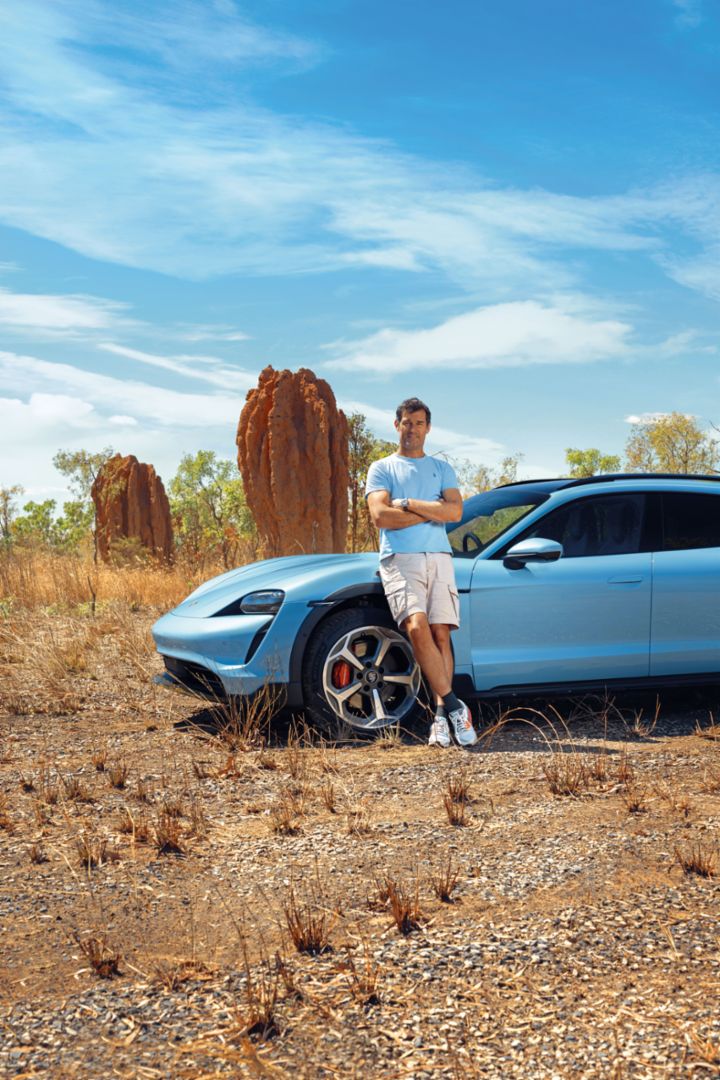
New territory:
The road trip is also a first for Mark Webber, Porsche brand ambassador and former race car driver. He discovers new regions – and electric travel – in his home country.An evening briefing is held at the Yacht Club in Darwin to get everyone involved on board. Like charging, the tires require a great deal of attention, as they need to be able to withstand the strain of on- and off-road driving. A Taycan 4S Cross Turismo will serve as the expedition vehicle. Thanks to standard features such as the outstanding Performance Battery Plus, all-wheel drive, air suspension, and up to 571 PS (Taycan 4S Cross Turismo (2023): Electric power consumption* combined (WLTP) 24.8 – 21.4 kWh/100 km, CO₂ emissions* combined (WLTP) 0 g/km, CO₂ class A ), the electric sports car offers the best conditions. Gravel Mode, which also comes standard, improves the vehicle’s ability to navigate poor road surfaces. “I can’t wait to see what we encounter along the way,” says Webber. “I enjoy long drives in my enduro machine and am always on the lookout for inspiration. But I’ve never had the courage to navigate the bush. There’s no one out there, and some of the terrain is extremely hostile. A breakdown out there could be dangerous.” Just to be on the safe side, we load up plenty of water and sunblock.
We set out in a southerly direction early the next morning. Stuart Highway is the most important artery in this area and the lifeline of the outback. Construction on the 2,720-kilometer road began in 1940 and wasn’t completed until 1987. There were still some gravel stretches in the south as recently as the 1980s. Our first destination after a drive of 223 kilometers is Pine Creek, a gold mining town that has been waiting in vain for the next gold rush since the 1890s. A small, blue sign of the Australian Electric Vehicle Association (AEVA) indicates a public AC charging station behind the only hotel in town. We connect the Taycan and are surprised to discover that the unassuming socket charges the vehicle with up to 22 kW, which is twice what we were expecting. A dream come true!
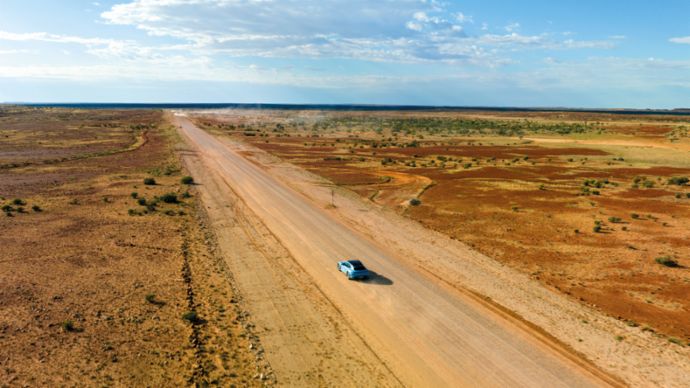
Alone in the wide expanse:
Whether on gravel roads in the outback or on a river cruise through Nitmiluk Gorge, the endless expanse of the Northern Territory is ever present on the journey.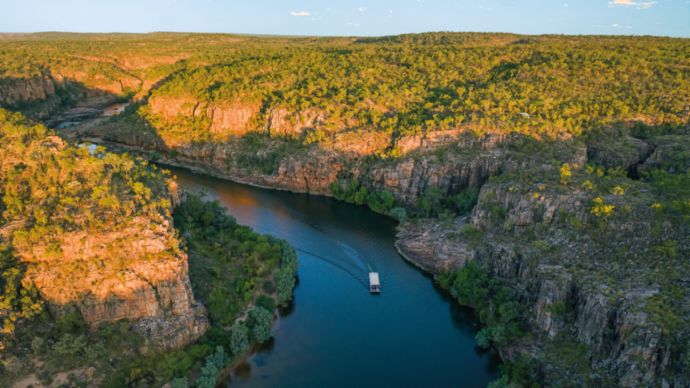
We leave the Taycan charging as we explore the surroundings. We take a river cruise through the spectacular Nitmiluk Gorge and learn everything we need to know about the region’s plants and animals. This terrain is the hunting grounds for the smaller freshwater crocodiles, in particular. The larger, more dominant saltwater crocodiles are captured in enormous cages and then released where they belong. The largest specimen caught this February was around five meters in length, which is almost as long as our Taycan. The excursion is concluded with a dinner on the boat of crocodile (how fitting), kangaroo, and chicken. As the sun slips below the horizon, thousands of bats dart back and forth overhead – a treat for the eyes. With evening now upon us, we return to the Cicada Lodge, a small bungalow facility with 18 rooms and a pool, which is just the right thing after a long day and temperatures in excess of 30 degrees Celsius. Parked next to reception, the Taycan charges to 100 percent overnight with an easygoing 2.3 kW. “I’m surprised at just how simple it has been so far,” says Webber. “We haven’t had a single issue, let alone a serious problem.”
We continue in a southerly direction the next morning, heading for Mataranka in Elsey National Park. At a temperature of 34 degrees Celsius, the thermal Bitter Springs are not exactly suitable for cooling down, but they do offer a relaxing bathing experience. The pool noodles seem to be an indispensable accessory. Tucked under your arms, they allow you to float leisurely around, which is exactly what we do, with the Taycan charging at the campsite across the way. With 22 kW, charging is again twice as fast as the information in the PlugShare app has led us to believe. The current flows, and the journey continues.
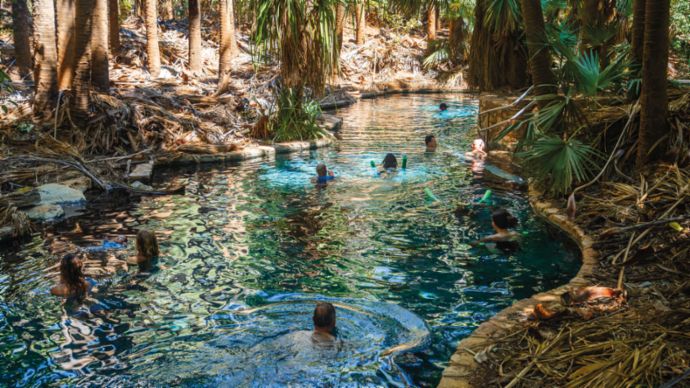
Natural spa environment:
At a temperature of 34 degrees Celsius, Bitter Springs in Elsey National Park won’t exactly cool you down, but they do offer relaxation.
But why is the charging process always faster than shown? PlugShare works exclusively with feedback provided by the EV community. Where can I charge? How much will it cost and how long will it take? And then it hits us: most of the other electric vehicles can only charge with maximum 11 kW AC, which is why they enter that as the maximum charging capacity. Because our Taycan features an AC charger with 22 kW, we increase our electric range by another 150 kilometers during lunch. And it’s no different at Larrimah Hotel and Caravan Park. In addition, the small, blue signs often tell you to inform the operator before initiating the charging process – and for good reason: the charging process can trip the fuses for a few other campers. Air conditioning and a washing machine in a camper plus the Taycan are a little too much for the transformer to handle.
Stuart Highway is largely empty. When you do see another car, nine times out of ten it’s a 4×4 truck with a V8 engine under the hood and a travel trailer in tow. The imposing road trains – trucks with four or five trailers – are just about everywhere. The maximum length permitted is 53.5 meters. They look like they wouldn’t brake for anything or anyone and barrel down the hot asphalt in the Red Centre, another name for the Northern Territory, at around 100 kmh.
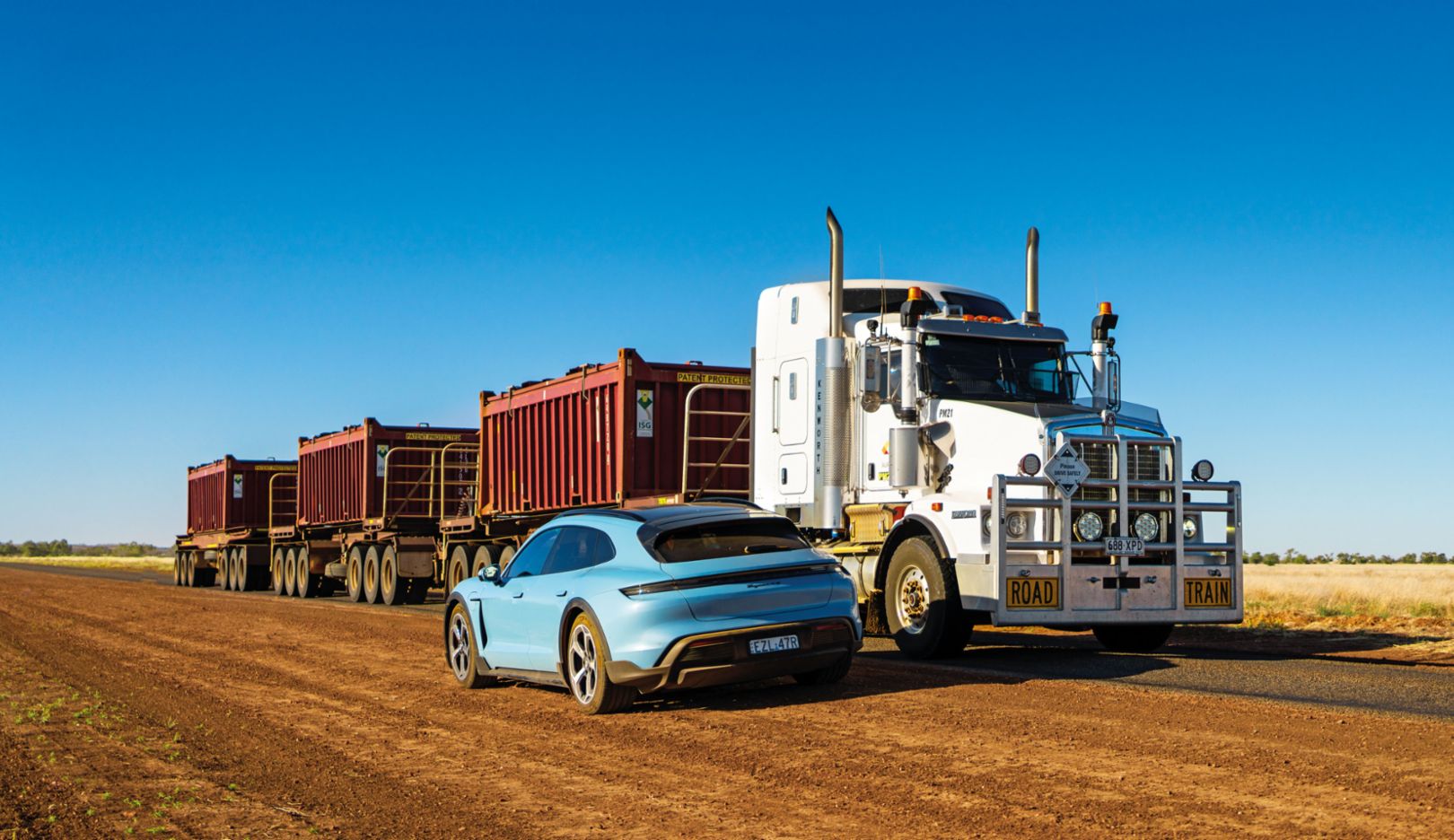
An imposing encounter:
With a maximum permitted length of 53.5 meters, the road trains often encountered in Australia can be ten times longer than the Taycan.We reach the old airport town of Daly Waters in the afternoon. With wrecked mid-century airplanes and cars lining the road, the whole town feels like an outdoor museum. Our accommodations are the simplest on our entire journey, but the entertainment is, by far, the best. At the Daly Waters Pub, the bar owner himself is the solo entertainer – with his trained donkey. Guests from all over the world have pinned mementos – from business cards and old bills to baseball caps and bras of all shapes and colors – to the bar counter, walls, and ceiling, filling the venue with life. For dinner, there’s beef ’n’ barra, which is the outback version of surf ’n’ turf: steak served with barramundi, a local predatory fish from the lates perch family. What a treat!
We have more than 400 kilometers ahead of us tomorrow, which we cover in good time. With a speed limit of 130 kmh most of the way, there is little braking or recovery. Consumption hovers around 25 kWh per 100 kilometers. We charge again at a campground, with three phases up to 22 kW. We arrive in Tennant Creek and check in to Safari Lodge, a more than sufficient motel with all the necessary comfort. We spend the evening exploring the local Sporties Club, a restaurant with integrated gaming area. We enter a different world behind the curtain of transparent PVC strips, which are designed to keep out the bugs. The rally video game with seat, pedals, and H-shifter is from 1995. The resolution is so pixelated you can barely tell which car you’re driving. A virtual journey into the past.
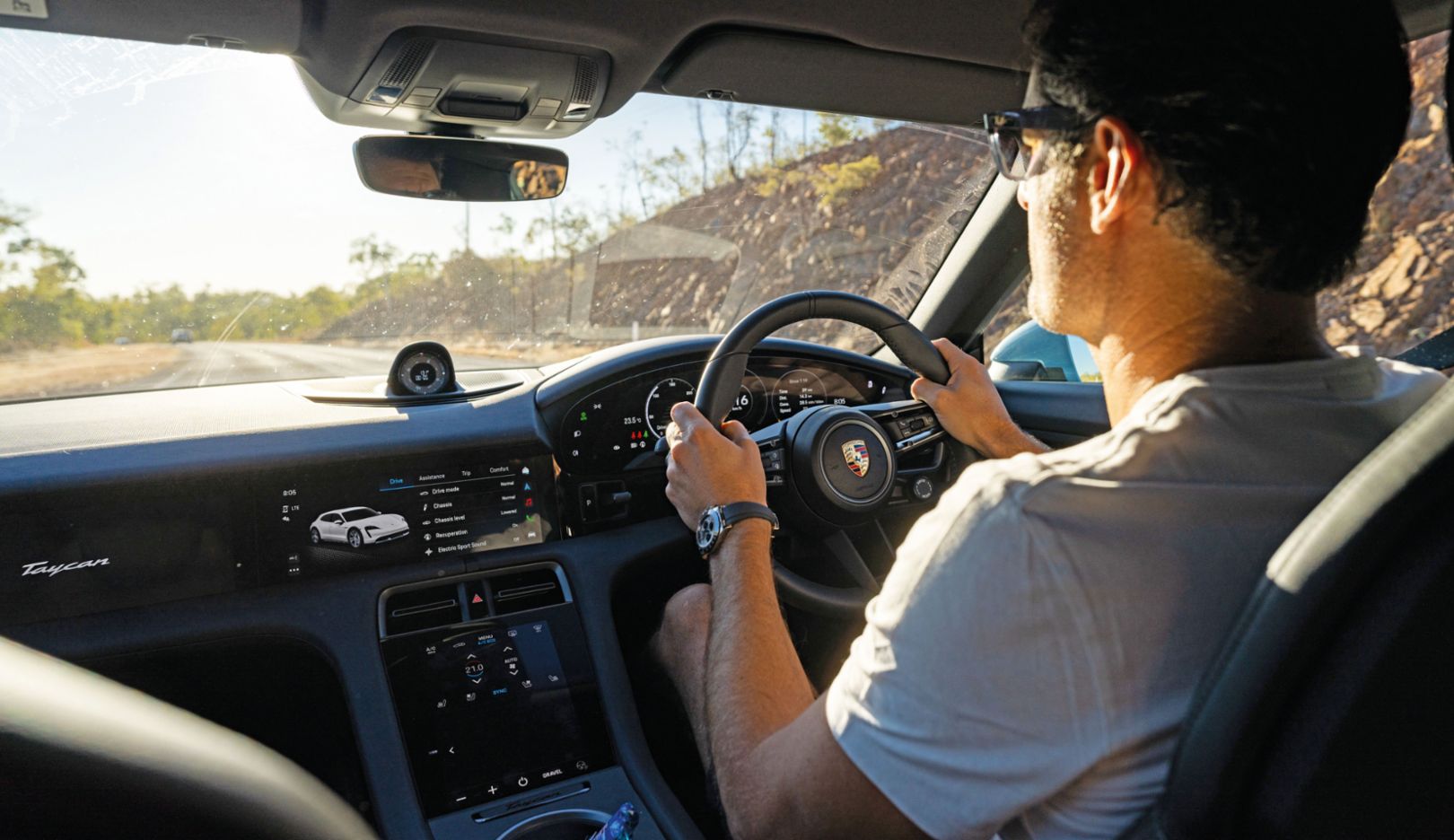
Journey of discovery:
Mark Webber is always on the lookout for inspiration for his motorcycle adventures – he finds it in the outback.Back in the present, we head out the next day for Devils Marbles, an imposing rocky landscape and holy land referred to as “Karlu Karlu” by the Aboriginal peoples, who are native to Australia and believe that almighty beings created all natural things and left behind their spirit and thus their spiritual energy at special places like this. With this story in our minds, the location has an almost magical feel about it, and we marvel at the extraordinary rock formations.
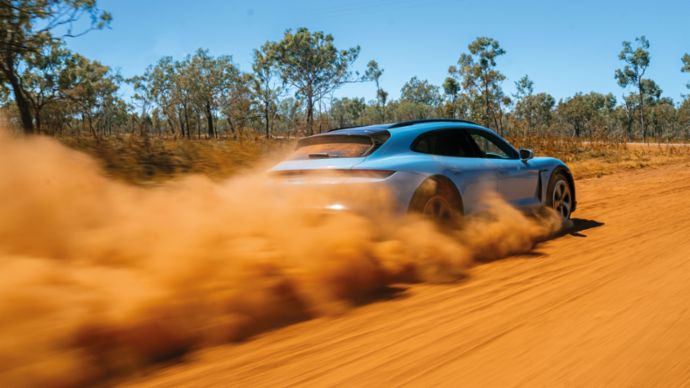
All-arounder:
Whether sand, gravel, or the asphalt of Stuart Highway, the Taycan can master them all with confidence.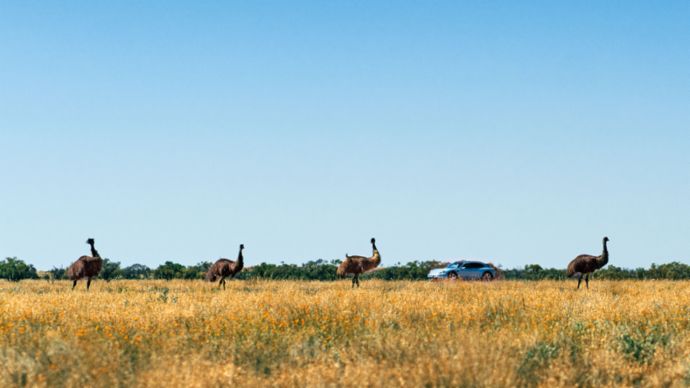
Communing with birds:
As if painted, the electric sports car fits in perfectly with the emus. It’s a meeting of two off-road experts – Australia’s largest bird species and the Taycan 4S Cross Turismo.Back in Tennant Creek, our journey comes to an end after 1,284 kilometers and 321 kilowatt-hours of charging. And what we’ve discovered is that the Taycan can also handle the outback. We didn’t have “range anxiety” even once. The rule of thumb is that every campground has a charging option. We ultimately paid less than 100 euros for electricity. Anything else? When the unbelievably friendly Australians want their diner burger with a side and garnish, they order it “with the lot” and, after the invitation to dinner, politely say, “thanks for tea.” Lots of impressions, and even more insights. Mark Webber, who had the opportunity to rediscover his home, agrees. “I’d never have thought that things would go so smoothly with an electric car in the outback,” says the 47-year-old. “And I definitely found new inspiration for future road trips.” Cheers, mate!
EXPLORE THE ROUTE YOURSELF
Discover the whole route taken in Australia in the Roads App.
The Australian Outback Challenge
How does the Taycan perform on an endurance route with a clear infrastructure? This question resulted in a spectacular road trip through Australia, from the Northern Territory to Bondi Beach in Sydney, with Christophorus tagging along for the first leg. After 5,000 kilometers, 19 days, and 27 charging stops, the crew finally reached its destination. The team usually charged overnight, for a combined 85 hours, and relied on a whole host of options, from charging at livestock farms and fast-charging stations to Porsche Destination Charging. The Taycan proved to be an all‑arounder, making short work of the demanding off-road conditions of the Australian wilderness. The adventure also demonstrated that electric vehicles can be integrated into everyday life with ease and that journeys like these are possible – and even convenient.
Additional information is available at newsroom.porsche.com

